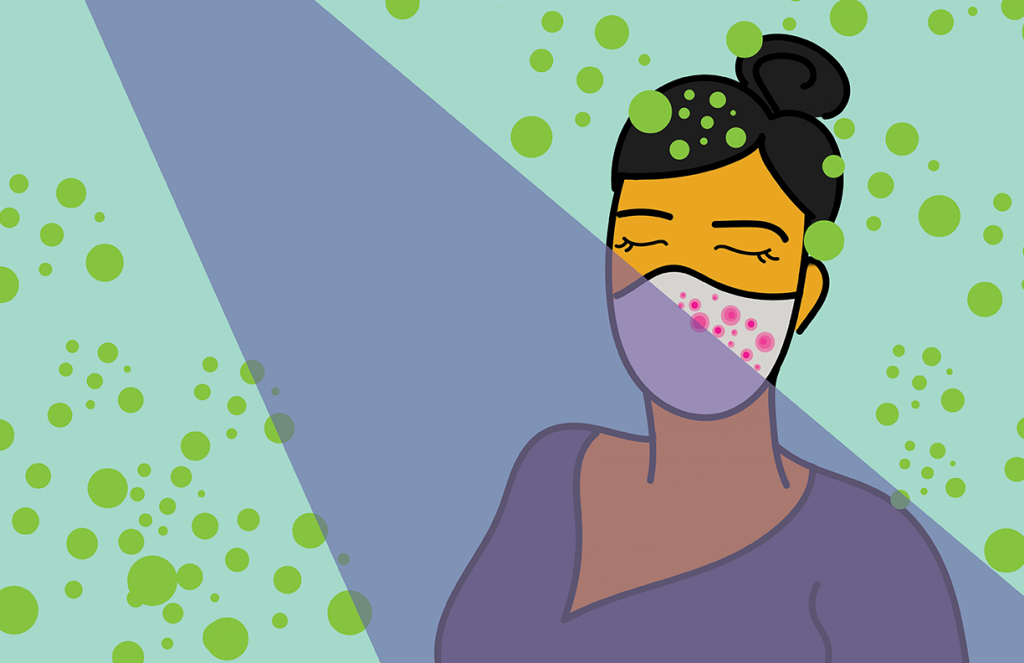Despite the disruption to the traditional collegiate setting at Binghamton University, researchers are not letting COVID-19 hinder their research capabilities.
During the Oct. 16 BU Council Meeting, it was revealed that 864 research personnel from 42 departments have resumed working on campus, with spaces at 25 percent capacity. The research division, specifically, currently has 40 percent of its employees working on site. There have been three positive tests in the research community.
Numerous innovations are currently being developed by BU professors and students in response to the COVID-19 pandemic.
Jeffrey Mativetsky, an associate professor of applied physics and astronomy, and Ahyeon Koh, an assistant professor of biomedical engineering, are developing a prototype of a mask that is capable of sensing the presence of respiratory viruses like COVID-19.
Matthew Brown, a fourth-year year Ph. D. student studying biomedical engineering, is a student researcher working with Mativetsky and Koh. Brown’s role in the research is mask integration.
“The goal of this project is to develop a real-time flexible electronic virus, [COVID-19], detection and respiratory sensor with continuous monitoring and [artificial intelligence] analysis,” Brown said. “Reusable plug-in electronic components will wirelessly transmit data to a smartphone and provide users with health status.”
While Brown was already working with Mativetsky and Koh on research, their current research project was not the initial plan.
“We were already collaborating as a group to develop a nanofibrous respiratory sensor to analyze breathing patterns,” Brown said. “Then, the pandemic happened, and we had a similar project that could be translated into [COVID-19] research. So, we slightly tweaked the project objective to make our goal more applicable to address [COVID-19] and build upon current mask technology.”
Ziqi Qing, a fifth-year Ph. D. student studying materials science and engineering, is also working with Mativetsky and Koh. Like Brown, Qing is working on mask integration.
“My role in this research is to prepare the active material, integrate it into the facial mask and measure its responses toward the several different activities, such as coughing, walking and speaking,” Qing said.
Given the unprecedented nature of these times, Qinq said research at BU has changed in terms of new guidelines and how meaningful it has become.
“Honestly, I feel like this research became more meaningful under the pandemic because it is very close to the human need at this moment, and our result may really help the person in need,” Qing stated.
Nathan Tumey, an assistant professor of pharmaceutical sciences, and Kanneboyina Nagaraju, founding chair of the School of Pharmacy and Pharmaceutical Sciences, are also conducting research relevant to the COVID-19 pandemic. Tumey and Nagaraju are researching ways to combat COVID-19 by using anti-inflammatory medications. While this does not provide a cure for COVID-19, the research aims to find a way to manage the disease by treating its symptoms, specifically by treating lung inflammation.
Further innovative research that is occurring at the University is being conducted by Kaiming Ye, director of the Center of Biomanufacturing for Regenerative Medicine at BU and department chair and professor of biomedical engineering, and Guy German, an associate professor and graduate program director of biomedical engineering. They are working to determine the amount of ultraviolet light (UV), specifically the subtype ultraviolet C (UVC), needed in order to properly disinfect and sterilize surfaces.
With their research, Ye and German are working to analyze how to control the function of tissue barriers in order to better understand their physical and mechanical properties while furthering their understanding of soft biological tissues. More specifically, Ye and German are trying to uncover what types of damage UV light causes to the structural and mechanical properties of the skin.
“The UV research will help us better understand the best ways to disinfect [personal protective equipment] using UVC light, and what UVC dosages are safe for human skin,” German said.
Like all research at BU, Ye and German’s project has been impacted by the COVID-19 pandemic and the University’s protocols.
“Research was temporarily halted,” German said. “However, this pandemic has really shown that a large number of scientists and engineers at [BU], including myself, can rapidly refocus their research goals to try to help improve societal health and well-being during epidemics and pandemics.”



